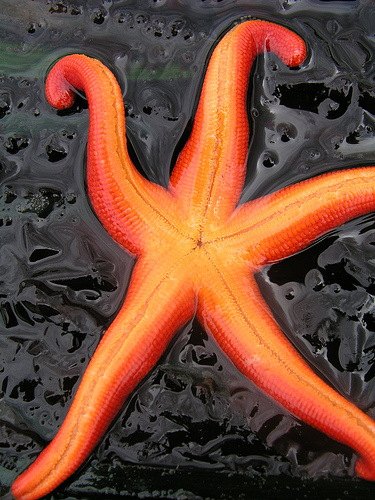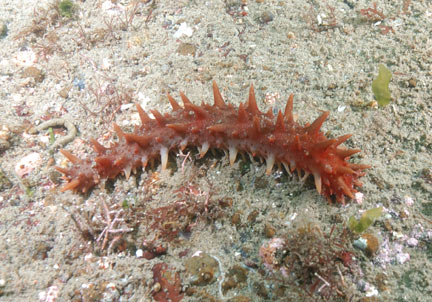
Echinoderms  |
|---|
Biology Feeding Reproduction Site Species Summaries Local Species References
Welcome to the wonderful world of echinoderms! This page was created as part of Dr. Bonnie Becker's Marine
Ecology course at the University of Washington, Tacoma. Each student was required to select a phylum associated with
the inter tidal zones of the marine environment and become the "specialist" for that phylum. On this site, you will find
information about the phylum Echinodermata: what they are, where they live, and how they live. You will also find some
information about the more common echinoderms in the Puget Sound and Washington coast regions and lists of the
various kinds of life encountered by the author at the sites visited by the class.
From the Greek words echin; meaning "spiny" and derma; meaning "skin", echinoderms belong to the phylum
Echinodermata and are sessile or slow moving invertebrates. There are over 7000 species and all are marine, with
the phylum being divided into six classes. Class Asteroidea are the Sea Stars that are sometimes called Starfish, but
are actually not fish at all. They will generally have five arms (although some species have many more), radiating from a
central disk and are often found clinging to rocky substrates of one form or another (the image at the top of the page is
that of Henricia leviuscula, the Blood Star). Class Ophiuroidea are known as Brittle Stars, and while they may
superficially resemble sea stars, they have a much more pronounced central disk and their
arms are long and flexible.

The Daisy Brittle Star (Ophiopholis aculeata). Photo from Elasmodiver.com
Class Echinodea contains the very recognizable Sea Urchins and Sand Dollars. These
species have no arms, but do have a shell-like internal skeleton known as a test. Sand dollar tests are what the
beachcomber will often find washed up on the shore.
.
The Pacific or Eccentric Sand Dollar, Dendraster eccentricus. Photo from Elasmodiver.com.
Class Holothuroidea are the Sea Cucumbers, and at first glance, they have little resemblance to
other echinoderms. They have no spines and their endoskeleton is greatly reduced, but they share certain traits with
other echinoderms that clearly show they do indeed belong in this phyla (See the section on Biology). 
The California Sea Cucumber (Parastichopus californicus) Photo from Elasmodiver.com
The above four classes contain examples of species that can be found in the intertidal zones; the areas of beaches and
shorelines that become exposed when the tides are low, but there are two other classes of echinoderms that are
considered deep water species and are not likely to be seen by the average beachcomber or diver. Class Crinoidea
contains animals known as Sea Lilies and Feather Stars. Both are considered suspension feeders . The last class is
Concentricycloidea and contains rare deep water animals known as a Sea Daisies.
Echinoderms occupy a wide range of habitats from intertidal zones (some Sea Stars and Sea Cucumbers)
to deep water (Sea Daisies and Sea Lilies). Nearly all species are benthic, living on the bottom on one type of substrate
or another: rocks, sandy bottoms, mud, and even on docks and pilings. Some may live in sheltered areas, under rocks or
in tide pools and some live fully exposed to the surf and the currents.
This web site was created by Geoff King for Dr. Bonnie Becker's Marine Ecology class. May, 2008. It is part of the
UWT Marine Ecology 2008 Class Project. URL address: http://courses.washington.edu/mareco08